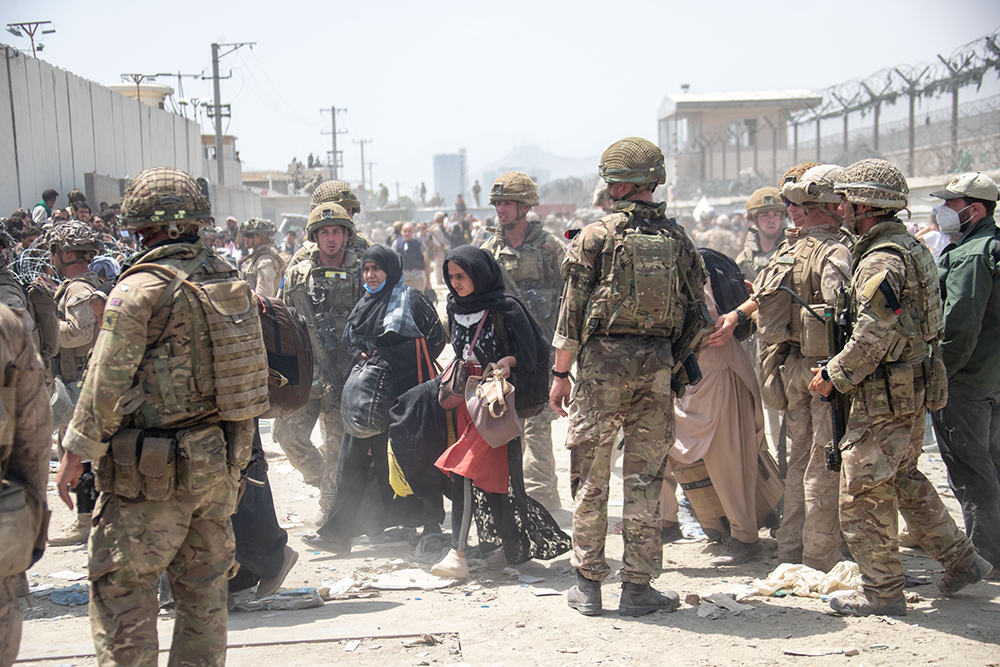Helping Afghan refugees escape Taliban retribution has not proved easy; ensuring their integration into their host countries more challenging still. In September 2021, a month after the United States completed its mass evacuation of refugees from Afghanistan, a serving female soldier was reportedly assaulted by a group of Afghan men at Fort Bliss in New Mexico. The incident caused a brief scandal but that was swiftly contained. Within six months, 76,000 Afghan evacuees had been processed and resettled into American communities.
The UK has taken a different approach. As part of the Afghan resettlement programme, around 39,000 refugees have been brought here since the fall of Kabul. Some 2,300 Afghans, many of them young men, are housed not in civilian accommodation, but on active Ministry of Defence property, including housing estates reserved outside military bases. This means they live alongside serving military personnel and their spouses and children. In some garrison towns, significant blocks of military housing have been effectively turned over to this purpose.
Soldiers and local government officials say that it is not always a harmonious arrangement. One soldier told me that groups of Afghan men stand outside family homes at all hours. Unregistered vehicles, he claimed, appear in the middle of the night, revving their engines. Women on the bases, the soldier added, have altered their dog-walking routes to avoid these groups, as some of the men react aggressively to dogs, even in some cases kicking them.
On Facebook groups for military personnel in the areas surrounding these barracks, similar complaints are made. One post from Alanbrooke barracks in North Yorkshire recently claimed Afghan teenagers were ganging up to fight local teenagers. Another post on a page about Durrington barracks in Wiltshire alleges an Afghan teenager stole flowers from a memorial on a bench outside a local Tesco. These are two isolated incidences, of course, but they illustrate unease among communities about the handling of Afghan resettlement.
Several soldiers I spoke to said that when concerns are raised and sent up the chain of command, they go unanswered. The assumption among personnel, whether or not it is correct, is that this intransigence is political, because senior members of the military establishment are unwilling to confront integration issues. Simon Diggins, a former colonel who served as defence attaché in Kabul between 2008 and 2010, told me that while successive governments worked hard ‘to get people into the country’, they did ‘not put time and money into integration’.
The country’s largest military base is Catterick in North Yorkshire. With a population of more than 14,000 and covering over 2,400 acres, since last September it has been home to around 64 settled Afghan families, housed mostly in MoD properties that were intended as service family accommodation.
The concerns expressed about recent Afghan arrivals is to do with the speed and scale of the change
Catterick is a town entirely shaped by the military and its history, and the names of the streets where many Afghan families find themselves reflect this. Amiens Crescent is named after the first world war battle where there were 22,000 British casualties; Aisne Road takes its name from the three battles where hundreds of thousands of Allied troops were killed or wounded. There were cans and crisp packets strewn outside the homes. Nearby Allenby Road – Viscount Allenby led the Egyptian Expeditionary Force against the Ottoman Empire – had become a fly-tipping site, with stained mattresses dumped on its grass verges.
The litter and tipping were unpleasant, but it was unclear who was responsible for the mess. While locals asserted that littering had increased recently, I could see no sign of groups of Afghan men standing around on the streets being intimidating, as some locals claimed.
One ex-serviceman in Catterick offered a more nuanced perspective on the Afghan resettlement. He told me the problem was not those who had served alongside the armed forces, but those who ‘bring their friends and family over’, as ‘this is how it starts’.
He was not the only soldier I spoke to who equivocated. Some military personnel felt the need to caveat their complaints about their new neighbours with assurances that they were not racist and that they valued their allies. Some spoke at length about their admiration for the Gurkhas and had positive things to say about other Commonwealth units and their families in the area (‘Commonwealth soldiers bring their families as well and nobody has an issue with that,’ one told me). The concerns expressed about recent Afghan arrivals is to do with the speed and scale of the change which military communities have faced.

‘You can’t read it – it’s covered by a superinjunction.’
Many soldiers have chosen to vote against these rapid changes with their feet. Serving and former personnel told me of colleagues who have quit the army in response to the Afghan resettlement – specifically for the safety of their families.
And now many of them are also planning to vote against what’s going on at the ballot box. One captain explained that when he was leading a training exercise during the 2024 election, almost every soldier under his command said they were planning to vote Reform. That was not just confined to the lower ranks. A local in Catterick said that of the five senior officers he knew, four intended to vote Reform at the next election.
Centrist politicians have long claimed that a vote for Reform is just a passing protest. But if those who have served in uniform see both main parties housing thousands of Afghans in homes which were designed for hard-pressed military families, this reaction is unsurprising.
The armed forces are the spine of the state – called upon when the NHS, the police, border force and prison services are stretched beyond capacity. If they feel their fears are going unaddressed, then their quiet quitting should concern us all.
